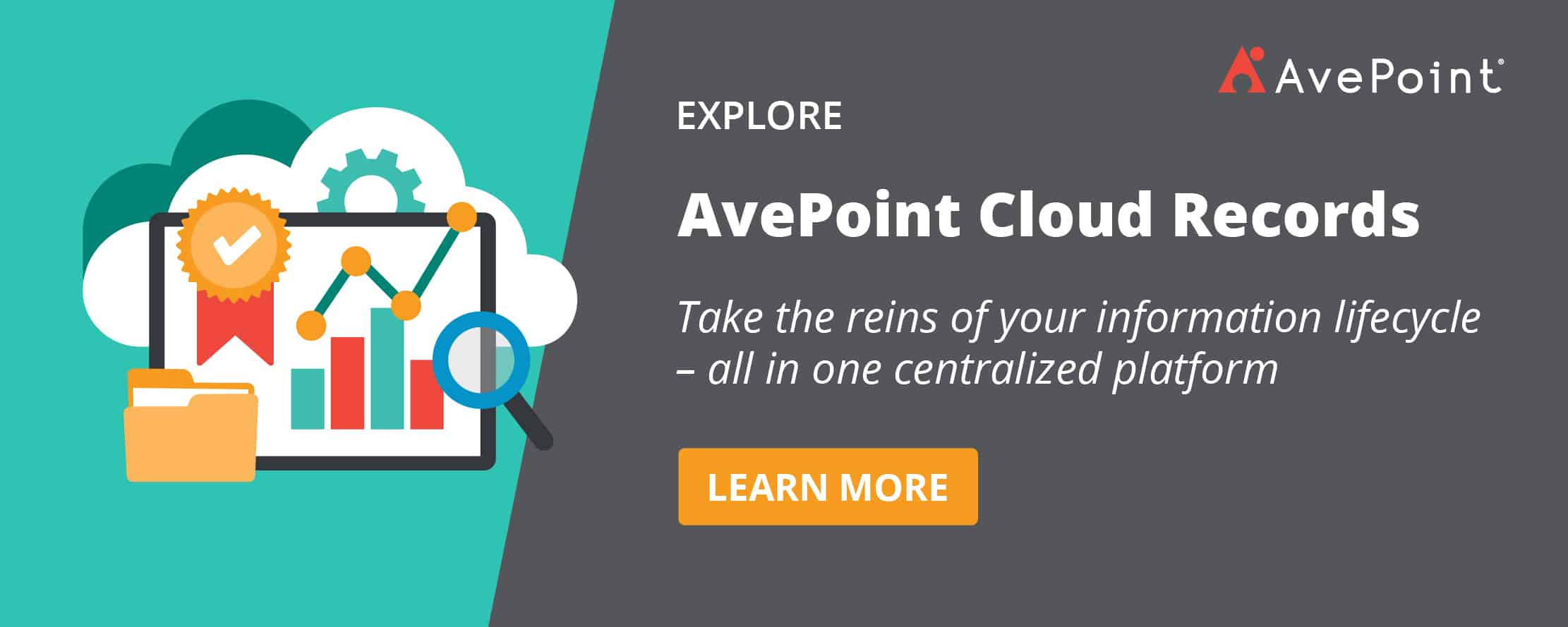As we move further into the digital age, achieving effective records management is crucial for government agencies. With Microsoft’s ongoing enhancements to Microsoft 365 and other products, managing records is now easier and more secure than ever for the public sector, streamlining workflows and enhancing data security.
Erica Toelle, Senior Product Marketing Manager at Microsoft, joined a recent episode of AvePoint’s Microsoft 365 Government Community Call Podcast to discuss how Microsoft is continuing to build out its data lifecycle and records management business in government cloud services.
Watch the full session below or keep reading to get the highlights of the episode!
Most Exciting Microsoft 365 Records Management Updates
Erica shared new capabilities for information management coming soon to government tenants in Microsoft 365.
Delegated administration for retention labels and policies
Coming this summer, admins will be able to divide up the administration of retention labels and policies within the same tenant. This new feature enables multiple records managers in the same tenant to create policies that are specific to their content, without being affected by the policies created by other managers in different agencies or departments. This new capability will work across compliance solutions like data loss prevention and information protection.
For agencies that share a single tenant or large agencies with multiple, discrete departments, this capability is a game changer. It streamlines processes while maintaining necessary security and compliance conditions, particularly for those with niche requirements. Overall, this new ability to tailor policies to your specific needs offers greater flexibility and customization while managing labels and policies.
Simulation mode for testing new policies before production
Records managers know that there’s a lot at stake in information management; the wrong retention label or misapplied policy could result in some serious consequences, perhaps even non-compliance. To prevent mistakes like this, it’s always a good idea to test something before implementing it in production.
Until recently, testing retention labels was not possible. However, with Microsoft’s new simulation mode, you can test a policy before it goes live. Simply create a policy, including the conditions you would like it to be applied, and start a simulation. By running a simulation, you can see how the policy would apply to different locations and assess whether the right permissions and policies are being applied to appropriate documents.
It’s always harder to roll something back once it hits production. By testing policies in a simulated environment without real-world consequences, you can ensure your policies are configured exactly as needed before going live, giving you confidence in any new labels.
Retention policy integration in workflows
Power Platform has been gaining popularity recently, and the automation offered by Power Automate is one of the most sought-after capabilities. With the new integration, you can now use a Power Automate workflow to apply a retention policy. This is huge news as so many organizations are using workflows as part of their common processes, creating a lot of records. This new feature streamlines the application of proper records management by automating retention labels and policies.
Moreover, the integration with Power Automate now allows for the automation of post-retention period actions. With a Power Automate workflow, a notification can be sent to a relevant person (based on file metadata) to determine the next course of action. This can be combined with a custom dashboard that offers possible actions, which can guide users to best practices.
With new integrations with Power Automate, records managers will have access to a whole world of customizations and controls, streamlining records management.
Best Practices for Records Management Success
In addition to covering the latest from Microsoft for records management, Erica shared her best practices for records management success based on real-world experiences. Let’s dive in to her top 3 tips!
1. Integrate where people work
Records managers know the most effective records management strategy is to integrate it where people do their work. This is one of the biggest perks of centralizing your records management in Microsoft 365.
Start by collaborating with business units to understand what tools their teams are using and how, so you can insert automated processes that streamline records management along the way. Solutions like AvePoint Cloud Records leverage automation to lift the burden of information management from end users, driving management best practices without relying on users to perform necessary tasks.
That means users can focus on their tasks without worrying about the complexities of managing records, and you can guarantee the information is properly managed, categorized, and protected.
2. Don’t overcomplicate it
Records managers must have a clear understanding of the laws and regulations their organization must follow. However, it’s important to understand what the laws say and not make it more complicated than it needs to be.
This applies to your own rules as well. While you may think you need complex labels and policies to meet requirements, excessive caution can stifle your team’s productivity and collaboration. Instead, find a balance between managing risks and prioritizing the user and the mission of the agency.
Create a simple framework for your records management that complies with legal requirements while supporting your team’s goals. This way, you can put the needs of your organization first, finding a way to achieve success while minimizing risks.
3. Let go of perfect
There is so much data these days – and the amount is only growing. Dell found that the amount of business has grown tenfold since 2016. If you wait for a perfect system to manage this data, you’ll be waiting forever.
Instead, identify where the highest risk exists or what your highest value data is and create a plan to protect and manage it. Everyone – whether in records management or life – has to start somewhere, and you can always go back and enhance or add later, particularly after learning how your team interacts with it and determining potential gaps in your system.
Conclusion
In the era of digital transformation, government organizations must prioritize proper records management to protect electronic records’ availability and integrity and ensure transparency, accountability, and efficient service delivery to citizens. By following best practices and leveraging features like Microsoft’s latest releases in Microsoft 365, the public sector can streamline information management while enhancing security and compliance.
Want more? Dive deeper into our guests’ insights when you watch the full session!




